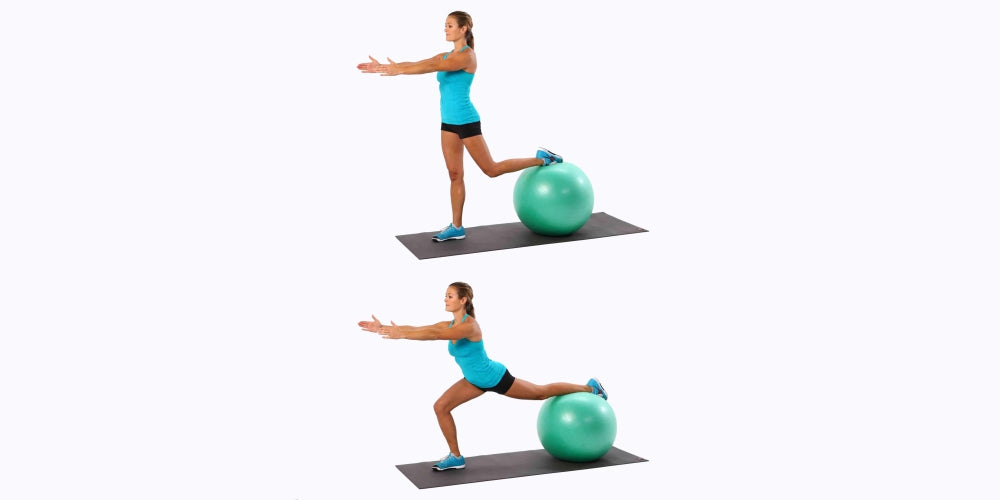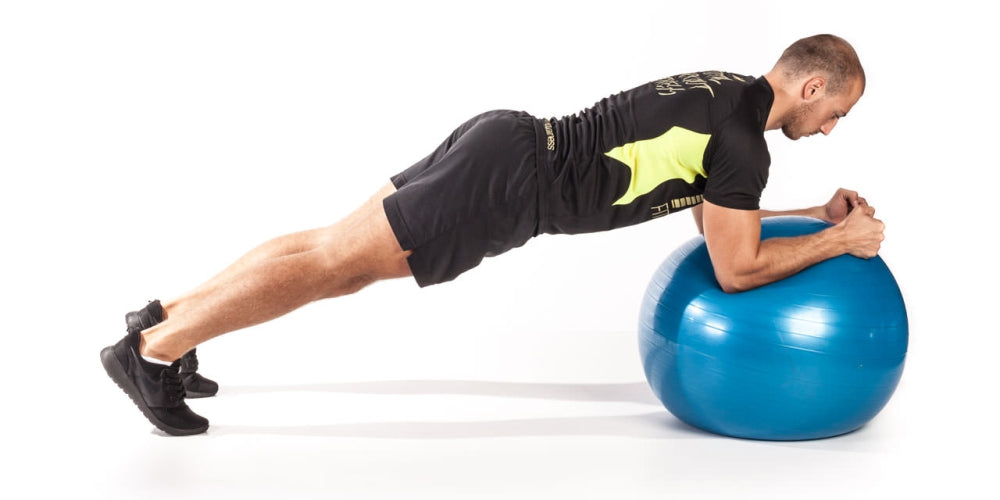Ball Exercise Workouts For Beginners: 7 Simple Exercises to Get Started
Are you tired of the same old gym routine? This versatile equipment can add a new challenge and variety to your workouts.
They’re inexpensive and can be used at home with minimal space. In this post, you’ll go over 7 simple exercise ball moves that are perfect for beginners.
1. Top 7 Ball Workout Exercises For Beginners
Exercise balls, also known as stability balls or Swiss balls, are versatile and affordable workout gear. They’re great for targeting specific muscle groups and improving balance, stability, and core strength.
They’re convenient to incorporate into a variety of exercises. Whether a beginner or a professional athlete, you can try any exercise ball workouts to get the desired perks.
1.1. Ball Squats

Ball squats are done using an exercise ball that targets your quadriceps, glutes, and lower back muscles and can be incorporated into various workouts to improve strength and stability.
To perform ball squats, follow these steps:
- Stand with your feet shoulder-width apart and hold the exercise ball in front of your chest.
- Lower yourself into a squat position, keeping your chest and back straight.
- Your knees should be bent at a 90-degree angle, and your weight should be evenly distributed on your heels.
- Press through your heels to stand back up, and then repeat the movement.
- It’s essential to keep proper form while performing ball squats. Keep your chest up and back straight, and avoid letting your knees extend over your toes.
- It’s also a good idea to start with lightweight to moderate weights and gradually increase the intensity.
Note: 3 sets are recommended.
1.2. Ball Curls

Knee folds can be performed with an exercise ball, also known as ball curls. This exercise targets your abdominal muscles and can be incorporated into various workouts to improve core strength and stability.
To perform knee folds on the exercise ball, follow these steps:
- Lay on the ground and keep the exercise ball under your lower back.
- Place your hands behind your head and lift your shoulders.
- Bring your knees towards your chest and lift your hips off the ground.
- Hold this position for a few seconds, then slowly lower your hips.
- Engage your core by keeping your back straight.
Note: 3 sets are recommended.
1.3. Ball Crunches

Ball Crunches are a core workout exercise that combines an exercise ball and traditional abdominal curl exercises. This simple but effective routine works your core, from your lower abs to your obliques, in a fluid motion. Exercise ball workout routines can increase the skill level and range of motion of athletes.
To perform ball crunches, follow these steps:
- Lie on your back with the ball placed under your lower back.
- Keep your feet planted on the floor for stability, cross your arms over your chest, or place them behind your ears if preferred.
- Inhale deeply, then exhale as you curl up, bringing your rib cage towards your pelvis while keeping the ball in place with no shifting or rocking motion involved.
Note: 3 sets are recommended.
1.4. Ball Push-Ups

Ball push-ups are an alternative form of the classic push-up, designed to increase muscular strength and endurance. Performing this exercise on a balance ball adds an extra challenge to the traditional push-up by requiring the body to remain in perfect alignment.
In addition, ball push-ups can provide an effective upper-body workout while helping to improve balance and coordination.
To perform a Ball Push-Up:
- First, begin with your feet on either side of the ball.
- Put your hands firmly on the floor directly beneath your shoulders.
- Keep a straight line from your head to your feet during this pose.
- Once you have achieved proper form, slowly lower yourself until your chest touches the ball, then press back up into the starting position.
Note: 3 sets are recommended.
1.5. Ball Bridges

Ball Bridges is a bodyweight exercise that strengthens the glutes, hamstrings, and core muscles. It is an effective way to tone the lower body and build muscle.
The main focus of this exercise is to strengthen the glutes and hip flexors by lifting your hips off the floor while keeping your knees bent at a 90-degree angle. You will also target your hamstrings and core as you use them to keep your legs in position while lifting.
To perform this move correctly:
- Start by laying on your back with your feet on the floor and your knees bent comfortably.
- Place the ball directly underneath your hips and press into it with your hands. Push off the ball as you raise your hips towards the ceiling while keeping your feet flat.
- Keep pushing until you have formed a bridge shape with your body, with only your shoulders remaining in contact with the ground.
- Hold this pose for 2-3 seconds before slowly releasing it back down to starting position.
Note: Repeat this move 10-15 times for best results.
1.6. Ball Lunges

Ball Lunges are an effective, low-impact exercise that can help strengthen the legs and core muscles. This exercise is perfect for improving their balance, posture, and overall stability. It only requires a stability ball – making it easy to do at home or in the gym.
To do the ball lunges exercise:
- You will begin by standing behind your ball.
- Squat into a deep lunge position with one foot on the ball and the other leg extended out behind you.
- Keep your back straight as you press through your heel onto the top of your ball, pushing up into a standing position.
- Keeping your balance on one leg, slowly lower yourself back into a lunge position before repeating this motion.
Note: Do it for 8-12 reps on each side.
1.7. Ball Planks

Ball Planks are an effective core-strengthening exercise that can help improve posture and balance. Using a stability ball to support the plank position, you can work harder to keep your body in alignment while performing the exercise. The incorporation of Ball Planks can make your routine enjoyable and help build improved muscle strength, coordination, and overall fitness.
This plank is recommended for people of all ages and fitness levels looking for creative ways to challenge their core muscles. In addition to working the abdominal muscles, it also targets the shoulders, arms, chest and lower back muscles – all of which are essential for good posture and balance.
Ball planks use static (holding a single position), and dynamic (repeated movement) exercises involving different movements, such as arm lifts or leg lifts, as part of a complete workout routine.
You can do this ball exercise by:
- First, place the large exercise ball on a flat surface.
- Place your hands on the ball and spread them shoulder-width apart.
- Your arms should be straight, with your elbows slightly bent.
- Next, raise your body off the ground using only your toes and forearms while keeping your back straight throughout the entire movement.
- Maintain this position for 20 seconds before slowly lowering yourself back to the starting position.
Note: Repeat it twice.
2. What Does an Exercise Ball Do? – Amazing Benefits to Explore
An exercise ball, also known as a stability ball or gym ball, is a large, inflatable ball often used as a piece of exercise equipment. It is best to perform different exercises that challenge balance, stability, and core strength. Here are some of the benefits of using an exercise ball workout:
2.1. Improves Balance and Stability
Because the ball is unstable, using it for exercises requires you to engage your core muscles and maintain balance. This can help improve your overall balance and stability, which can be especially beneficial for athletes or older adults at risk of falls.
2.2. Develops Core Strength
Many exercises on an exercise ball require you to engage your core muscles to maintain balance and stability. It will strengthen your abdominal muscles and improve your overall core strength.
2.3. Support Flexibility
Using an exercise ball can improve your range of motion and flexibility. For example, performing stretches on the ball can allow you to stretch deeper than you might on the ground.
2.4. Increases Muscle Activation
The unstable surface of an exercise ball can help activate more muscle fibers during specific exercises, leading to increased muscle strength and endurance.
2.5. Expand Cardiovascular Endurance
Some exercise ball workouts such as mountain climbers or plank jacks, can provide a cardiovascular challenge and boost your endurance.
3. FAQs
3.1. Is Bouncing on an Exercise Ball Real Exercise?
An exercise ball is designed to help with strength training and core stability exercises. It is believed that using an exercise ball promotes movement within a greater range of motion and helps with posture. Additionally, bouncing on the ball can increase overall coordination and balance. So, it is a real exercise with some real benefits.
3.2. What are Some Great Hip Exercises (No Weights)?
- Lunges are one of the simplest yet most effective moves for targeting your glutes and thighs.
- Ball workouts are also beneficial because they require no weight and are easier to do.
- Glute bridges are another excellent exercise that engages your glutes and strengthens your hamstrings and lower back muscles.
3.3. Why Should You Try the 25-Minute Stability Ball Exercise?
Exercising on a stability ball is an excellent way to improve your core strength, balance, and posture. Doing it for 25 minutes can help you engage multiple muscles at once and challenge yourself to reach new heights of physical fitness.
3.4. Are Gym Machines Bad For You?
Trying gym machines is good and bad as well. It is good in the sense that it gives you all the things under a roof. It is bad because it makes you habitual and depends on the machines.
4. Final Words
Using an exercise ball is beneficial to add variety and intensity to your workout routine. It can help you target difficult areas, improve balance, and increase your overall strength.
With the 7 simple moves outlined in this article, you now have the necessary information to start your Balls exercise workout as a beginner. Remember to take it slow at first, as it takes time for the body to become accustomed to new movements.
